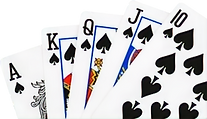

ROUND
- PREFLOP
The first stage of the game is known as preflop. Each person is dealt two cards face down. These cards are known as the hole cards or pocket cards. Every hand the two players sitting to the immediate left of the dealer have to make a compulsory bet known as the blinds. The player on the dealer’s left is the small blind and pays half the ante while the big blind who is on his left pays the whole ante. This is so as to get the betting started. After every hand the dealer moves to the left so too does who the blinds are. As the blinds are already in the preflop betting round commences with the person to the left of the big blind. Every other player has the choice to bet, fold and raise on seeing their cards. If everyone bets both blinds still have the option of raising if they so want or folding if someone previously has raised. These are universal texas hold’em poker rules.
- FLOP
After the betting round has concluded the flop takes place which is three cards which are placed face up in the middle of the table. These cards are referred to as community cards and each player can use them however he wants to make the best possible hand. A round of betting follows beginning with the first player to the left of the dealer who is still in the hand.
- TURN
A fourth community card otherwise referred to as the Turn is revealed with another round of betting ensuing. This round of betting again begins with the first player to the left of the dealer who is still in the hand.
- RIVER
A fifth community card otherwise referred to as the River is revealed with another round of betting ensuing. Like the previous two, this round of betting again begins with the first player to the left of the dealer who is still in the hand.
Play of the hand
Play begins with each player being dealt two cards face down, with the player in the small blind receiving the first card and the player in the button seat receiving the last card dealt. (As in most poker games, the deck is a standard 52-card deck containing no jokers.) These cards are the player’s hole or pocket cards. These are the only cards each player will receive individually, and they will only (possibly) be revealed at the showdown, making Texas hold ‘em a closed poker game.
The hand begins with a “pre-flop” betting round, beginning with the player to the left of the big blind (or the player to the left of the dealer, if no blinds are used) and continuing clockwise. A round of betting continues until every player has folded, put in all of their chips, or matched the amount put in by all other active players. See betting for a detailed account. Note that the blinds are considered “live” in the pre-flop betting round, meaning that they are counted toward the amount that the blind player must contribute. If all players call around to the player in the big blind position, that player may either check or raise.
After the pre-flop betting round, assuming there remain at least two players taking part in the hand, the dealer deals a flop, three face-up community cards. The flop is followed by a second betting round. This and all subsequent betting rounds begin with the player to the dealer’s left and continue clockwise.
After the flop betting round ends, a single community card (called the turn or fourth street) is dealt, followed by a third betting round. A final single community card (called the river or fifth street) is then dealt, followed by a fourth betting round and the showdown, if necessary.
In all casinos, the dealer will burn a card before the flop, turn, and river. Because of this burn, players who are betting cannot see the back of the next community card to come. This is done for historical/traditional reasons, to avoid any possibility of a player knowing in advance the next card to be dealt due to it being marked.
BETTING RULES

- MINUMUM RAISE
A player may not raise an amount that is less than the big blind amount.
- BLINDS
The blinds are forced bets placed by two players to the left of the dealer button. Generally, the “big blind” is equal to the minimum bet. The “small blind” is normallu half the big blind.
- ANTE
An ante is a forced bet in which players that enter game put “big blind” equal amount into the pot before the deal begins.
- ALL-IN
If you do not have enough money to call a bet, you may go ‘all-in’. This means that you are betting everything you have left. If you go all-in, you are not allowed to win more than you were able to call. If the pot increases after you go all-in and you win, the pot will be split between you and player with the next hand who was able to cover the raises.
Betting structures
Hold ‘em is normally played using small and big blind bets – forced bets by two players. Antes (forced contributions by all players) may be used in addition to blinds, particularly in later stages of tournament play.
A dealer button is used to represent the player in the dealer position; the dealer button rotates clockwise after each hand, changing the position of the dealer and blinds.
The small blind is posted by the player to the left of the dealer and is usually equal to half of the big blind. The big blind, posted by the player to the left of the small blind, is equal to the minimum bet. In tournament poker, the blind/ante structure periodically increases as the tournament progresses. (In some cases, the small blind is some other fraction of a small bet; e.g., $10 is a common small blind when the big blind is $15, and still other tables may use two equal blinds. The double-blind structure described above is a commonly used and more recent adoption.)
When only two players remain, special ‘head-to-head’ or ‘heads up’ rules are enforced and the blinds are posted differently. In this case, the person with the dealer button posts the small blind, while his/her opponent places the big blind. The dealer acts first before the flop. After the flop, the dealer acts last and continues to do so for the remainder of the hand.
The three most common variations of hold ‘em are limit hold ‘em, no-limit hold ‘em and pot-limit hold ‘em. Limit hold ‘em has historically been the most popular form of hold ‘em found in casino live action games in the United States.
In limit hold ‘em, bets and raises during the first two rounds of betting (pre-flop and flop) must be equal to the big blind; this amount is called the small bet. In the next two rounds of betting (turn and river), bets and raises must be equal to twice the big blind; this amount is called the big bet. No-limit hold ‘em is the form most commonly found in televised tournament poker and is the game played in the main event of the World Series of Poker.
In no-limit hold ‘em, players may bet or raise any amount over the minimum raise up to all of the chips the player has at the table (called an all-in bet). The minimum raise is equal to the size of the previous bet or raise. If someone wishes to re-raise, they must raise at least the amount of the previous raise.
For example, if the big blind is $2 and there is a raise of $6 to a total of $8, a re-raise must be at least $6 more for a total of $14. If a raise or re-raise is all-in and does not equal the size of the previous raise, the initial raiser cannot re-raise again. This only matters of course if there were a call before the re-raise. In pot-limit hold ‘em, the maximum raise is the current size of the pot (including the amount needed to call).
Most casinos that offer hold ‘em also allow the player to the left of the big blind to post an optional live straddle, usually double the amount of the big blind, which then acts as the big blind. No-limit games may also allow multiple re-straddles, in any amount that would be a legal raise.

GETTING CHIPS
Lottery : Every day FREE lottery chips.
Level Bonus : Each time you level up two, we will pay out bonuses.

